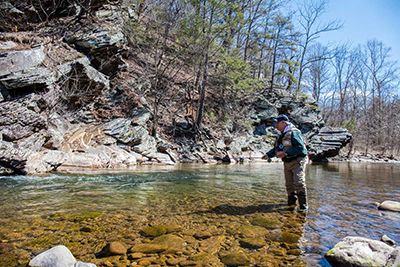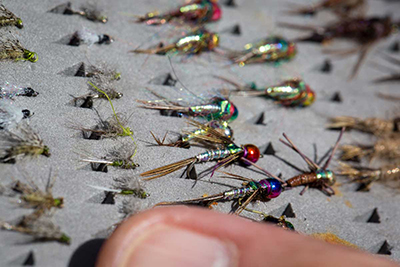
Gary Lang wades into the cold water of the Upper Elk River, steadying himself on the slippery rocks in the riverbed. It’s morning, just after breakfast. The pale March sun shines overhead, lighting up Lang’s blue eyes as he brings his fishing rod around and makes his first cast of the day.
This is how his work day begins. Lang is an Orvis fly fishing guide, meaning he will spend his day accompanying his customers from a local lodge to the best trout fishing spots on streams near the small Appalachian town of Elkins, West Virginia, showing them how to tie on the correct fly patterns and teaching them proper casting techniques.
Lang, 65, is no novice at this. He began fly fishing about 40 years ago and has been hooked ever since. It’s become a lifelong love not only for fishing, but also for the natural beauty of the crystal-clear trout streams and the tall greenery surrounding Elkins.
He’s proof, too, that conservation and commerce aren’t mutually exclusive. In making a living in the streams of West Virginia, Lang also is helping look after them. While serving as president of the local Trout Unlimited chapter, Lang worked with the U.S. Fish and Wildlife Service (Service) on several habitat improvement projects, many of them conducted on the streams where he guides.
“There is nothing better than spending your day outside in beautiful surroundings, in a country you know and appreciate,” he said.
Lang got into guiding in 1988 because of a friend, who wanted him to show an Orvis representative the local surroundings. A renowned retail and mail-order business based in Vermont, Orvis specializes in fly fishing equipment and other sporting goods. Lang agreed to host a tour of the Elkins area.
Elkins is located at the confluence of the Tygart Valley River and Leading Creek, a stone’s throw from the Monongahela National Forest. It is in a group of West Virginia counties sometimes referred to as “The Birthplace of Rivers,” making it a perfect haven for fly fishers — a rare find in the Northeast, Lang noted.
From that first tour, Lang would continue working with Orvis, guiding in-season as a side job — perhaps one of the best side jobs one can get.
“I’m just here to have a good time,” he said. “This is just my thing.”
There’s more to fly fishing than there might seem; watching from afar, it looks like you just whip the line into the water and hope a fish snags it at the surface. Not so, according to Lang: fly fishing is more about knowing your surroundings, knowing the season and knowing your flies. And depending on a person’s physical ability, it can also mean scrambling down into the uneven footing of a river for several hours at a time.
“We walk the river,” said Lang. “You might walk a couple of miles in a day.”
But it’s the patterns — or “ties” — for the flies that are really key; each mimics a different kind of insect at a specific stage of its lifetime. The fish are looking for this — they know what time of year it is and what they should be feeding on, and will only chase certain flies. This makes the preparation before casting essential, as the flies and their life stages are seasonal, and are different in certain areas as well.
“You have to know what’s happening,” said Lang. “It could be the difference between catching zero and catching 50.”
It’s this extensive knowledge that has won Lang many customers over the years. One of those customers, Beau Beasley of Virginia, has used Lang’s expertise on a number of occasions. Though Beasley, too, is a seasoned fly fisher and outdoor writer in his home state, he leaned on Lang’s innate familiarity with Elkins’s rivers while writing a guidebook on fishing in the mid-Atlantic U.S.
“Gary knows the rivers like only a local can, and not only knows how to approach the stream, but what flies to use and when,” said Beasley. “I would feel completely comfortable with Gary guiding my wife, one of my children, or the most experienced angler I know.”

Anglers also need the cold, clear water that native brook and other trout use as their habitat. Over the years, Lang has worked with a number of different groups, including TU and the Service, to protect that habitat.
Lang credits his involvement with TU to a West Virginia’s infamous “Election Day Flood” of November 1985, an event he says “may have been the highest water ever” for that area. The flood waters were so intense that year that they washed away much of Elkins’ riverbanks, and even overran a nearby archaeological site.
Statewide, the flooding cost nearly $700 million in damage and claimed 38 lives. When the rivers finally receded, the region’s riverbanks were very unstable, prompting a number of local landowners to try to straighten the river using bulldozers. Hardest hit was the North Fork South Branch Potomac River.
“Seventy-six bulldozers took what was once a beautiful river, and when they got done it was basically a 30-mile culvert,” Lang said.
The crumbling banks lit a fire under Lang, who couldn’t bear to see the rivers he fished and guided on fall into disrepair. Encouraged by a friend, he began working with Elkins’ TU chapter, going on to serve there for 10 years, rising quickly to president, and working to restore the rivers to their natural splendor. Lang’s restoration work would eventually lead him to partner with the Service on a number of projects, including removing invasive species and excluding cattle from West Virginia riverbanks.
Since 2010, the Service has partnered with local landowners, TU, and The Nature Conservancy to eradicate knotweed, a pernicious perennial plant that has threatened to destabilize riverbanks all across West Virginia.
Knotweed’s root system emits a poison so strong that it can kill its own seedlings — and any other plant that dares to seat itself too close. Knotweed also outcompetes most other plants with its ability to steady itself on even the most loosely packed riverbanks. This means it takes the place of native, shade-giving plants that trout in the stream need to keep the water cool — and to feed the flies they eat.
Removing knotweed and keeping native vegetation in place not only preserves the shade-giving plants required to keep the water cold, but also provides leaves as food for flies. More flies plus cold water generally means more trout — which can mean more customers for Lang.
“Needless to say, it’s a pretty dangerous invasive to have growing nearby,” said John Schmidt, Field Supervisor for the Service’s West Virginia Field Office in Elkins, which has coordinated much of the habitat work. “It can overtake any plant community on the riparian area.”
To fight the invasive, the Service and partners have carried out a number of treatments along Seneca Creek, Thorn Creek, Slaty Fork, and the Upper Elk River — all places where Lang guides.
“Recreation is really important here,” said Schmidt. “We have great trout fishing, and it’s a big tourist attraction. The streams are really, really important to people making a living off them.”
In addition, the Service has worked with farmers in the state to secure nearly 2 million feet of cattle-exclusion and field division fencing. Not only does this allow the farmers to increase grazing efficiency and improve their bottom line, but it helps prevent grazing cows from further destabilizing the riverbanks, keeps cows’ excrement out of the stream, and keeps the water clean and clear for the fish — and for those who try to catch them.
“Our work is definitely helping to protect and boost trout populations,” Schmidt said.
Schmidt himself guides occasionally on these rivers, having learned how to fly fish from Lang. The two have become friends over the years, bonding over their conservation efforts (and the occasional poker night). To both men, preserving the rivers isn’t just about keeping them native; it’s about preserving them for future generations of wildlife and people alike to enjoy.
“Fishing gets way better when the water is cleaner,” Schmidt said.
For people like Lang who rely on the rivers, this work has gone a long way in keeping them pristine.
“Most people aren’t about the numbers or the big fish - they care about the stream and the experience,” he said.
For him, it’s just another reason to keep going out there.
“This still fascinates me,” Lang said, reaching back for another cast into the cold swirling water. “I still care about it, and I still want to do it as long as I can.”
 Sign In
Sign In
 Sign In
Sign In
